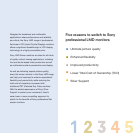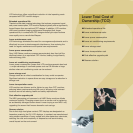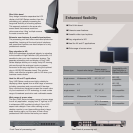
Lower Total Cost of
Ownership (TCO)
LCD technology offers a significant reduction in total operating costs
compared with CRT monitor designs:
Extended operational life
Thanks to solid state imaging technology that reduces component count
and power consumption, LCD monitor displays typically offer a significantly
longer lifespan than conventional CRT designs. In addition, LCD monitors
offer more consistent imaging performance throughout their longer
operational life, in contrast with CRT designs where light output reduces
more rapidly over a more limited lifespan.
Lower maintenance costs
LCD technology eliminates the need for convergence adjustments and is
effectively immune to electromagnetic interference, thus reducing the
need for regular maintenance and special care requirements.
Lower power consumption
Sony LMD Series monitors consume approximately less than half the
electrical power of an equivalent CRT monitor, leading to significantly
reduced energy bills.
Lower air conditioning requirements
Lower power consumption means that LCD monitors generate less heat
– a major advantage in confined spaces such as OB vehicles or large
studios where air conditioning costs can be reduced.
Lower storage cost
Storage costs are a critical consideration for busy rental companies.
Significant reduction in space allows an easy storage and a reduction in
storage cost.
Lower transportation costs
LCD monitors are slimmer and far lighter to carry than CRT monitors,
reducing labour requirements and the cost of shipping units between
locations as well as relaxing health and safety requirements.
Cost-effective upgrade path
The MEU processing unit common to all LMD Series monitors affords
maximum flexibility. Changing screen size in a monitor wall or replacing
an accidentally damaged screen doesn’t mean buying a new MEU: only
upgrading the screen itself means dramatic cost savings.
Greener solution
Due to their high lead glass content, CRT displays are designated as
hazardous waste by the EU. LCD displays, in contrast, are manufactured
using smaller quantities of heavy metals and other hazardous chemicals,
reducing the cost and complexity of disposal as well as minimising
overall impact on the environment.
■
Extended operational life
■ Lower maintenance costs
■ Lower power consumption
■ Lower air conditioning requirements
■ Lower storage cost
■ Lower transportation cost
■ Cost-effective upgrade path
■ Greener solution










